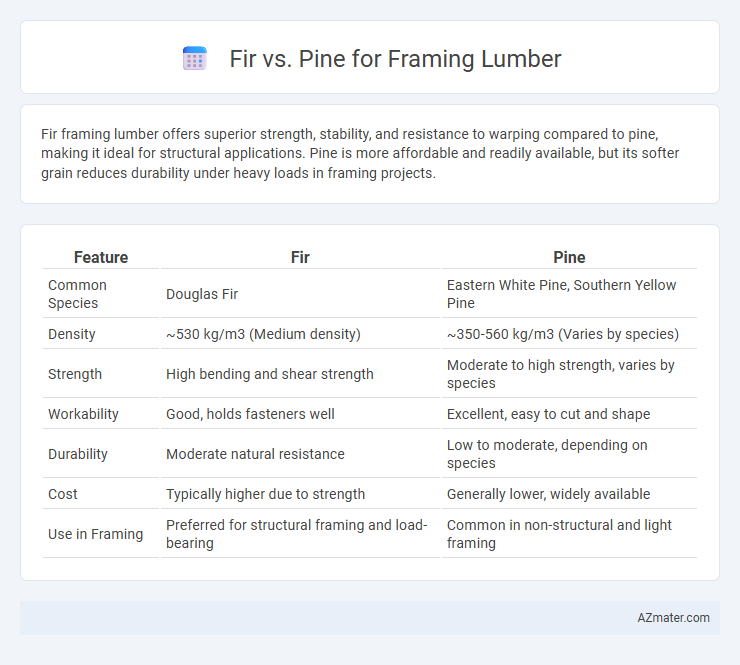Fir framing lumber offers superior strength, stability, and resistance to warping compared to pine, making it ideal for structural applications. Pine is more affordable and readily available, but its softer grain reduces durability under heavy loads in framing projects.
Table of Comparison
| Feature | Fir | Pine |
|---|---|---|
| Common Species | Douglas Fir | Eastern White Pine, Southern Yellow Pine |
| Density | ~530 kg/m3 (Medium density) | ~350-560 kg/m3 (Varies by species) |
| Strength | High bending and shear strength | Moderate to high strength, varies by species |
| Workability | Good, holds fasteners well | Excellent, easy to cut and shape |
| Durability | Moderate natural resistance | Low to moderate, depending on species |
| Cost | Typically higher due to strength | Generally lower, widely available |
| Use in Framing | Preferred for structural framing and load-bearing | Common in non-structural and light framing |
Introduction to Fir and Pine as Framing Lumber
Fir and pine are two of the most common softwood options used in framing lumber, each offering distinct structural properties. Douglas fir is renowned for its high strength-to-weight ratio and excellent stability, making it a preferred choice for load-bearing applications. Pine, particularly Southern yellow pine, provides robust durability and ease of workability, often favored for residential framing projects due to its availability and cost-effectiveness.
Key Differences Between Fir and Pine Wood
Fir wood offers higher strength and rigidity, making it ideal for structural framing where load-bearing capacity is critical, while pine tends to be softer and more prone to dents but is easier to work with for detailed carpentry. Fir typically has a tighter grain pattern and fewer knots compared to pine, providing better dimensional stability and a smoother finish for construction projects. Pine's lighter weight and greater availability make it a more cost-effective option for non-structural elements, whereas fir's durability justifies its higher price for robust framing.
Strength and Structural Performance
Fir framing lumber exhibits superior strength and stiffness compared to pine, making it highly suitable for load-bearing applications and structural framing. Douglas fir's dense grain and high modulus of elasticity contribute to excellent dimensional stability and resistance to deformation under stress. Pine, while generally more affordable and easier to work with, often lacks the comparable strength and may require additional reinforcement in critical structural components.
Durability and Longevity
Douglas fir offers superior durability and longevity compared to most pine species, making it a preferred choice for framing lumber in construction. Fir's dense grain structure enhances its resistance to warping, shrinking, and insect damage, providing a stable and long-lasting framework. Pine, while more affordable and easier to work with, generally has lower strength and is more susceptible to wear and environmental factors over time.
Workability and Ease of Use
Fir lumber is favored for framing due to its excellent workability, characterized by straight grain and minimal knots that simplify cutting and nailing. Pine also offers ease of use but tends to be softer, which can lead to dents and damage during handling or installation. Fir's consistent density and strength provide better structural stability, making it a preferred choice for builders prioritizing durability and precision.
Cost Comparison: Fir vs Pine
Fir lumber typically costs more than pine due to its higher strength-to-weight ratio and durability, making it a preferred choice for structural framing despite the price difference. Pine remains a more budget-friendly option, offering adequate performance for residential framing projects with lower initial investment. Comparing cost-effectiveness, fir provides long-term value through reduced maintenance and increased longevity, while pine suits projects prioritizing upfront savings.
Availability and Sourcing
Fir framing lumber is widely available in North America, primarily sourced from the western United States and Canada, making it a reliable choice for large-scale construction projects. Pine, commonly sourced from the southern United States, offers abundant availability but may vary in quality depending on species such as Southern Yellow Pine or Eastern White Pine. Both fir and pine are sustainably harvested, with fir generally favored for its consistent strength and pine valued for its cost-effectiveness and regional accessibility.
Environmental Impact and Sustainability
Fir and pine both serve as popular choices for framing lumber, yet fir generally demonstrates superior environmental sustainability due to its faster growth rates and efficient carbon sequestration capabilities. Pine's widespread availability can reduce transportation emissions, but fir's higher strength-to-weight ratio promotes less material usage and longer-lasting structures. Sustainable forestry certifications, such as FSC and SFI, are crucial for both species to ensure responsible harvesting and minimal ecological disruption.
Best Uses and Applications in Construction
Fir framing lumber offers superior strength and stiffness, making it ideal for load-bearing structures such as beams and joists in residential and commercial construction. Pine, softer and lighter, suits non-load-bearing applications like interior wall studs, sheathing, and trim where ease of cutting and handling are priorities. Both species resist warping and shrinkage, but fir's enhanced dimensional stability makes it preferable for critical framing elements subject to heavy stress.
Conclusion: Choosing the Right Lumber for Your Project
Fir offers superior strength and stability, making it ideal for load-bearing framing applications, while pine provides greater availability and cost-effectiveness for lighter framing needs. Both fir and pine are widely used in construction, but selecting fir ensures enhanced durability in heavy structural projects, whereas pine suits budget-sensitive builds without compromising basic structural integrity. Assess project requirements carefully to balance cost, strength, and availability when choosing between fir and pine framing lumber.

Infographic: Fir vs Pine for Framing Lumber
 azmater.com
azmater.com